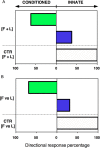Learning by Association in Plants
- PMID: 27910933
- PMCID: PMC5133544
- DOI: 10.1038/srep38427
Learning by Association in Plants
Abstract
In complex and ever-changing environments, resources such as food are often scarce and unevenly distributed in space and time. Therefore, utilizing external cues to locate and remember high-quality sources allows more efficient foraging, thus increasing chances for survival. Associations between environmental cues and food are readily formed because of the tangible benefits they confer. While examples of the key role they play in shaping foraging behaviours are widespread in the animal world, the possibility that plants are also able to acquire learned associations to guide their foraging behaviour has never been demonstrated. Here we show that this type of learning occurs in the garden pea, Pisum sativum. By using a Y-maze task, we show that the position of a neutral cue, predicting the location of a light source, affected the direction of plant growth. This learned behaviour prevailed over innate phototropism. Notably, learning was successful only when it occurred during the subjective day, suggesting that behavioural performance is regulated by metabolic demands. Our results show that associative learning is an essential component of plant behaviour. We conclude that associative learning represents a universal adaptive mechanism shared by both animals and plants.
Figures



Comment in
-
Lack of evidence for associative learning in pea plants.Elife. 2020 Jun 23;9:e57614. doi: 10.7554/eLife.57614. Elife. 2020. PMID: 32573434 Free PMC article.
Similar articles
-
Lack of evidence for associative learning in pea plants.Elife. 2020 Jun 23;9:e57614. doi: 10.7554/eLife.57614. Elife. 2020. PMID: 32573434 Free PMC article.
-
De novo transcriptome assembly reveals high transcriptional complexity in Pisum sativum axillary buds and shows rapid changes in expression of diurnally regulated genes.BMC Genomics. 2017 Mar 2;18(1):221. doi: 10.1186/s12864-017-3577-x. BMC Genomics. 2017. PMID: 28253862 Free PMC article.
-
Comment on 'Lack of evidence for associative learning in pea plants'.Elife. 2020 Sep 10;9:e61141. doi: 10.7554/eLife.61141. Elife. 2020. PMID: 32909941 Free PMC article.
-
Omics resources and omics-enabled approaches for achieving high productivity and improved quality in pea (Pisum sativum L.).Theor Appl Genet. 2021 Mar;134(3):755-776. doi: 10.1007/s00122-020-03751-5. Epub 2021 Jan 12. Theor Appl Genet. 2021. PMID: 33433637 Review.
-
Hydrotropism: the current state of our knowledge.J Plant Res. 1997 Jun;110(1098):163-9. doi: 10.1007/BF02509304. J Plant Res. 1997. PMID: 11541137 Review.
Cited by
-
Biofeedback-Based Closed-Loop Phytoactuation in Vertical Farming and Controlled-Environment Agriculture.Biomimetics (Basel). 2024 Oct 18;9(10):640. doi: 10.3390/biomimetics9100640. Biomimetics (Basel). 2024. PMID: 39451847 Free PMC article.
-
Vegetal memory through the lens of transcriptomic changes - recent progress and future practical prospects for exploiting plant transcriptional memory.Plant Signal Behav. 2024 Dec 31;19(1):2383515. doi: 10.1080/15592324.2024.2383515. Epub 2024 Jul 30. Plant Signal Behav. 2024. PMID: 39077764 Free PMC article. Review.
-
Can Plants Perceive Human Gestures? Using AI to Track Eurythmic Human-Plant Interaction.Biomimetics (Basel). 2024 May 12;9(5):290. doi: 10.3390/biomimetics9050290. Biomimetics (Basel). 2024. PMID: 38786500 Free PMC article.
-
The "plant neurobiology" revolution.Plant Signal Behav. 2024 Dec 31;19(1):2345413. doi: 10.1080/15592324.2024.2345413. Epub 2024 May 6. Plant Signal Behav. 2024. PMID: 38709727 Free PMC article. Review.
-
Extending cognition: a vegetal rejoinder to extensionless thought and to extended cognition.Plant Signal Behav. 2024 Dec 31;19(1):2345984. doi: 10.1080/15592324.2024.2345984. Epub 2024 Apr 23. Plant Signal Behav. 2024. PMID: 38654490 Free PMC article.
References
-
- Merkle J. A., Fortin D. & Morales J. M. A memory-based foraging tactic reveals an adaptive mechanism for restricted space use. Ecol. Lett. 17, 924–931 (2014). - PubMed
-
- Whitfield M., Köhler A. & Nicholson S. W. Sunbirds increase foraging success by using color as a cue for nectar quality. Behav. Ecol. 25, 328–334 (2014).
-
- Aristotle, Nicomachean Ethics: Translation, introduction, and commentary (Trans. and Intro Broadie S. & Rowe C.) (Oxford University Press, 2002).
Publication types
MeSH terms
LinkOut - more resources
Full Text Sources
Other Literature Sources


